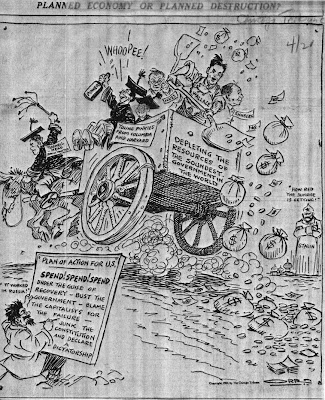"This is a 1934 Chicago Tribune political cartoon that many say rings true in today's political and economic climate. What do you think?"

And the analysis of the cartoon from The Federal Observer:
The man in the mortarboard flogging the Democratic donkey is Rex Tugwell, the leader of FDR’s “Brain Trust”, a character out of academica. The Brain Trust was supposed to come up with new ideas to help America. The two mortarboard-wearing kids in the wagon represent recent Ivy League college graduates hired to staff the New Deal. The cartoonist from the conservative Chicago Tribune, Mr. Orr, is calling them socialist “pinkos” (term that wasn’t then in use, “pinkies’ is what Orr called them).
The most prominently featured man shoveling money off the wagon is Secretary of Agriculture Henry Wallace, who was known for his socialist leanings. Most us are aware that FDR confiscated gold in 1934, but most people are not aware that the gold confiscation was a clause in the Agricultural Adjustment Act of 1934. It is also important to remember that 90% of the American population lived on farms during the Depression.
The man behind Wallace is Harold L. Ickes, Secretary of the Interior and director of the Public Works Administration. As head of the PWA, Ickes had a lot of say on what and where public works projects were built. The biggest of course was the Tennessee Valley Authority. Ickes was well-known for backing many other socialist endeavors. Ickes was also the father of Harold M. Ickes, a key player in the Clinton administration.
The other man behind Wallace was a mystery to me. In fact, I had trouble reading the label on him in the cartoon. That man is Donald Richberg, who was called “assistant president” in the FDR administration. Both he and Ickes came through Chicago politics and were leaders of the Progressive movement there. Both Ickes and Richberg were key players in pushing the National Industrial Recovery Act which imposed fascist codes of conduct on American industry which dictated how key industries in America were to be run. The National Recovery Administration was ultimately struck down by the Supreme Court in 1935, which decision led to FDR’s effort to “pack” the Supreme Court with more cooperative justices.
The significance of this cartoon is that it depicts the visible signs of manipulation by the financial elite that runs America, which was in full control of the country back during the Depression, for decades before that and for the decades leading up to the present.
D. Dial
History repeats itself.









who is the audience in this cartoon? and what other artists' reflection is on this cartoon?
ReplyDelete